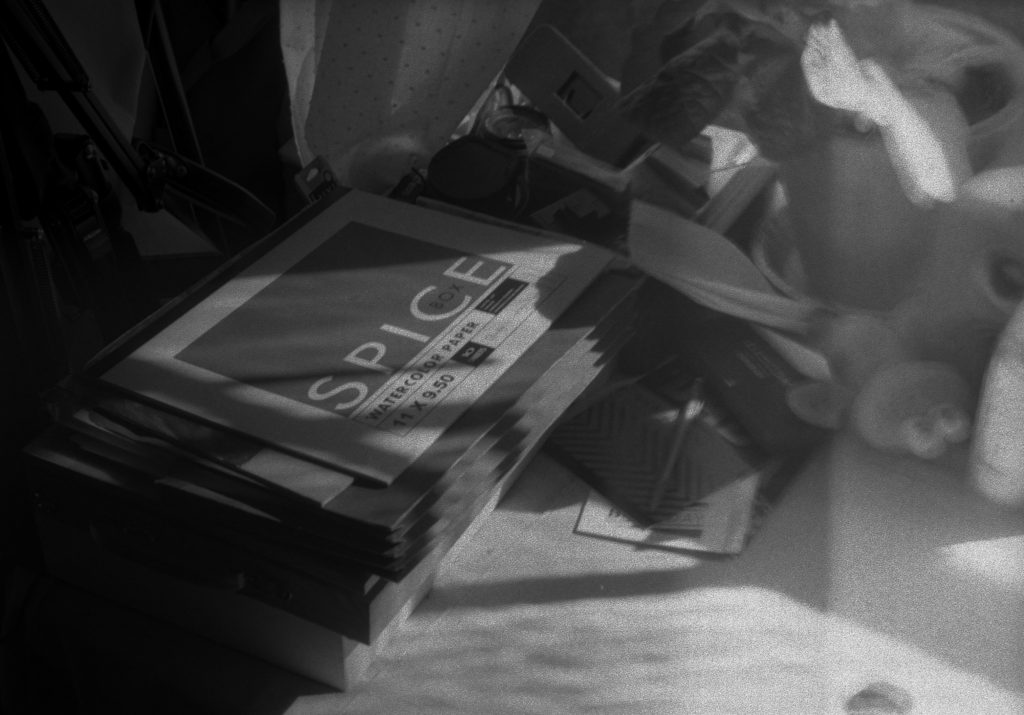At one point, I stopped using Tri-X because it curled so badly. Then, I figured out how to stop the curling, which I wrote about in October 2023. Last year, when Kodak lowered the price, I decided to stock up on Tri-X because at $7.99 for 24 frames, it wasn’t that much more expensive than Kentmere 400, and I prefer 24-frame rolls much of the time.
DF96 is my go-to developer. I began using it in early 2020 because I lost access to the public darkroom I’d been using. Every roll of B&W film I have developed since March of 2020 has been developed using DF96, so I was shocked when two rolls, one HP5+ and one Tri-X, reticulated badly. Until those two rolls, I had never had a problem with reticulation. I was completely baffled!?!
Searching online, I saw a number of forum posts attributing the reticulation to monobaths in general and DF96 in particular. The posts went back three or four years. Yet, having used DF96 for five years and being happy with the results, I could not easily attribute the cause to the monobath. I wrote to CineStill, and they sent a link to a video addressing the problem. After reviewing the video, I tried again—one roll each of HP5+ and Tri-X. Once again, both rolls reticulated. However, I also developed Kentmere 200 and 400 in the tanks with the Tri-X and HP5+, and both rolls of Kentmere were fine. Now, I was more puzzled than before.
Trying to solve the reticulation problem, the scientist in me took over. I did something I had never done with DF96– using a water bath to maintain the temp of the dev tank at 70F. I sat the PhotoFlo mixture in the water bath, which was about 71F, and developed two more test rolls of Tri-X and HP5+, and again, both reticulated, but not as severely. What ?!?!?
What was going on? Maybe it was time to go back to my darkroom days, get some Ilford DD-X, and forget DF96 for Tri-X and HP5+. After all, I had plenty of both in the freezer, and DF96 may have been ruining my negatives–but why now?
For the next few days, I racked my brain, looking for what I was doing differently this time. In October 2023, I was delighted with DF96 and Tri-X, and now, disaster each time—it made no sense. The only change that I could think of that happened between 2023 and now was that I stored my chemicals in a first-floor bathroom instead of an upstairs office. That was it, and why should that change make a difference??? Then I remembered that the upstairs office was always warm.
Solutions kept in the office sat on a carpeted floor, and they were 75-77F year-round. When using DF96, I would use the solution straight from the container and develop using the directions for 75F. No cooling of DF96 or PhotoFlo was done. Then it hit me. Now that I stored my chemicals downstairs, the DF96 had to be heated to 72F. Further, when I had previously sat the PhotoFlo in the water bath, I had assumed it would warm to at least 68-72F, but I never checked the actual temp. Did cold PhotoFlo cause the reticulation?
I set up a water bath at 70F and put in a container of PhotoFlo. After waiting approximately the same amount of time for the PhotoFlo to warm, I checked the temp. The PhotoFlo solution was still too cold— in the low 60s. Finally, I checked the main jug sitting on the floor—the temp was 58. At the time, the room temp was about 73F. The marble floor was keeping those liquids much cooler than expected! After three weeks of tearing my hair out, I had the likely cause.

Excited to have a possible answer, I shot ten frames of HP5+ and ten frames of Tri-X. This time, I created a water bath, put the DF96 and PhotoFlo in that bath, and checked their temps. When both were between 70-72F, I developed the film as usual and used the warmed PhotoFlo—no reticulation!
For years, I had only developed upstairs and had never needed to warm the PhotoFlo, so that step was not part of my mental workflow map. Who knew that moving my chemicals would cause a three-week-long mystery?














